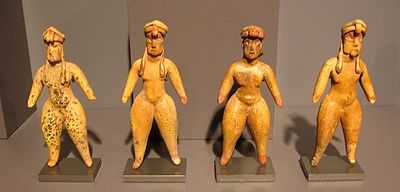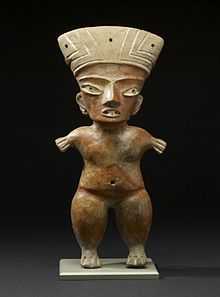Tlapacoya (Mesoamerican site)

Tlapacoya is an important archaeological site in Mexico, located at the foot of the Tlapacoya volcano, southeast of Mexico City, on the former shore of Lake Chalco. Tlapacoya was a major site for the Tlatilco culture.
Tlapacoya is known in particular for Tlapacoya figurines. These sophisticated earthware figurines were generally created between 1500 and 300 BCE and are representative of the Preclassic Period.
Tlapacoya was also a manufacturing center for so-called "Dragon Pots" (see photo below).[1] These flat-bottomed cylindrical bowls have white or buff surfaces incised with almost abstract Olmec-style drawings, generally of were-jaguars.
Even more ancient remains?

In addition to the figurines and other artifacts from the 1500 - 300 BCE era, human and animal remains have been found, some of which could be as much as 25,000 years old.
Silvia González et al. have published research claiming that "one Tlapacoya skull is the first directly dated human in Mexico with an age of 9730 ± 65 years BP" (before present). If confirmed, this would be the 2nd oldest human remain found in the Americas, after the Buhl woman of Idaho.
The most controversial findings in Tlapacoya are artifacts which have been dated by some researchers to as early as 25,000 BP. If verified, these would be some of the earliest dates for human habitation in the Americas and would discredit prevailing theories of the timing of settlement of the New World.
The evidence for these much-earlier dates consists of the bones of black bear and two species of deer which appeared in middens associated with 22,000-year-old hearths, as well as a curved obsidian blade which was found beneath a buried tree trunk. The bones were 24,000 years BP (± 4000 years) and 21,700 years BP (± 500 years) (Lorenzo and Mirambell 1999:488-489). The obsidian blade was found under a tree trunk which dated to 24,000 years BP (± 1000 years) and was itself dated, using the obsidian hydration method, to between 21,250 and 25,000 years BP.
These very early pre-Clovis dates have been challenged by other archaeologists.
The site was uncovered during the construction of a Mexico City-Puebla freeway in the 1960s and 1970s. It has since been almost completely obliterated by freeway construction.
Tlapacoya is in the lower right corner
See also
- Zohapilco
- Human antiquity in Mesoamerica
- Christine Niederberger Betton
References
- Diehl, Richard A. (2004) The Olmecs: America's First Civilization, Thames & Hudson, London.
- Dixon, E.J. (1999) Bones, Boats & Bison: Archaeology and the First Colonization of Western North America. Albuquerque: University of New Mexico Press.
- Gonzalez, S., Huddart, D., Morett-Alatorre, L., Arroyo-Cabrales, J., Polaco, O.J. Mammoths, volcanism and early humans in the basin of Mexico during the Late Pleistocene/Early Holocene, World of Elephants - International Congress Rome 2001
- Lorenzo, Jose Luis, and Lorena Mirambell (1999) "The Inhabitants of Mexico During the Upper Pleistocene" in Ice Age People of North America, edited by Robson Bonnichsen and Karen Turnmire, pp. 482–496. Oregon State University Press, Corvallis.
- Lorenzo, Jose Luis, and Lorena Mirambell, Coordinadores (1986) Tlapacoya: 35.000 aZos de Historia del Lago de Chalco. México, D.F. I.N.A.H., collección Científica, Serie Prehistórica, pp. 296.
| Wikimedia Commons has media related to Tlapacoya. |
Notes
- ↑ Diehl, Ch. 7.
External links
- Anthropologist K. Kris Hirst discusses Tlapacoya at about.com
- Article en Español on Silvia González
- Discussion of the pre-Clovis dating at Tlapacoya and further links
Links to figurine photos
- "A beautiful example from the early settlement of Tlapacoya . . . with undeniable Olmec inspiration"
- A more primitive figurine
- Standing Tlapacoya Pottery Female, Pre Classic Period, ca. 800 to 300 BCE
Coordinates: 19°18′06″N 98°54′46″W / 19.30167°N 98.91278°W